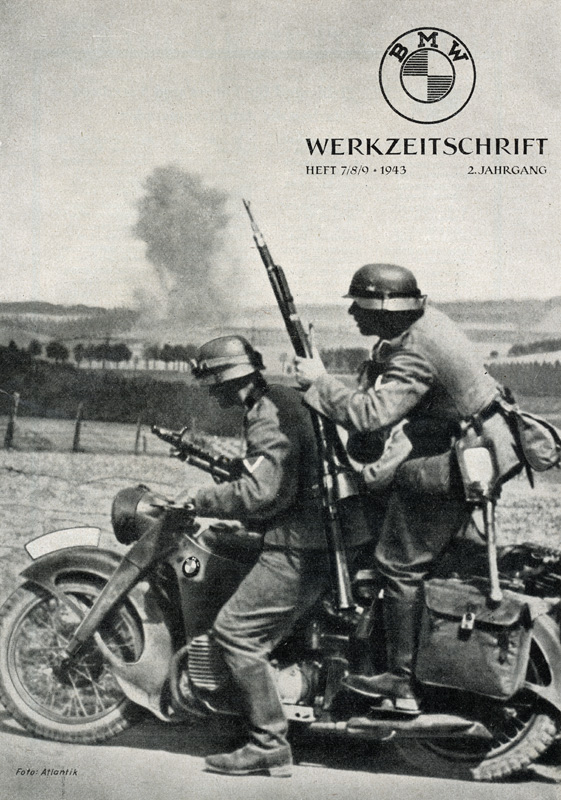München wird gewöhnlich nicht als Industriezentrum, sondern als Kultur- und Kunstmetropole wahrgenommen. Dennoch war die Stadt bereits Mitte der 1930er-Jahre der größte Industriestandort Bayerns. Insbesondere die mittelständische Qualitätsfertigung spielte im Münchner Wirtschaftsleben eine zentrale Rolle. Nach der „Machtergreifung“ erlebte die Münchner Wirtschaft einen bis Kriegsende andauernden Wachstumsboom, denn die nationalsozialistische Politik der „Wehrhaftmachung“ räumte der Rüstungsproduktion hohe Priorität ein.
Auch zahlreiche klein- und mittelständische Unternehmen, Handwerksbetriebe und Baufirmen konnten von der Rüstungskonjunktur profitieren und ihre Kapazitäten beträchtlich ausweiten. Seit Kriegsbeginn bildete die Luftrüstung eine industrielle Dominante der Münchner Wirtschaft. Die Stadt verfügte mit hochspezialisierten Handwerks- und Industriebetrieben und einer großen Zahl bestens ausgebildeter Facharbeiter*innen über ideale strukturelle Voraussetzungen für ein Zentrum der Rüstungsindustrie. Hinzu kam die geographische Nähe prominenter Flugzeug- und Flugmotorenhersteller. Neben Niederlassungen der Junkers-Werke in Allach, der Dornier-Werke in Aubing und Oberpfaffenhofen, der Messerschmitt-Werke in Augsburg sowie der Luftfahrtforschungsanstalt München-Ottobrunn komplettierten Unternehmen der optischen und feinmechanischen Industrie die spezifische Münchner Rüstungsstruktur: Rodenstock, Steinheil, Perutz, Agfa und andere fertigten Komponenten oder komplette Baugruppen für die Luftwaffe.
Mobilmachung, anhaltende Einberufungen zur Wehrmacht und die kriegsbedingte Ausweitung der Industrieproduktion sorgten in der deutschen Wirtschaft seit Ende der 1930er-Jahre für einen besorgniserregenden Arbeitskräftemangel. Durch die Ausweitung der Frauenarbeit und die Reaktivierung von Rentnern und Pensionären konnte dieses Problem nicht gelöst werden. Auch durch Rationalisierungsmaßnahmen bei den Fertigungsabläufen konnte die Produktivität nicht im erforderlichen Umfang gesteigert werden. Dies führte zum millionenfachen Einsatz ausländischer Männer, Frauen und Kinder. Ohne diese Zwangsarbeiter*innen wäre die deutsche Rüstungs- und Konsumgüterfertigung zusammengebrochen. Auch die Instandhaltung von Infrastruktur- und Versorgungseinrichtungen sowie die Sicherstellung der landwirtschaftlichen Erzeugung waren nur durch einen großangelegten „Ausländereinsatz“ möglich.
Wichtigster privatwirtschaftlicher Arbeitgeber und gewissermaßen das Herzstück des Industriestandortes München waren die Bayerischen Motoren Werke (BMW). Der Grundstein für die Erfolgsgeschichte der BMW war die Fertigung von Flugmotoren während des Ersten Weltkriegs. In den 1920er Jahren gelang es dem Unternehmen, fast nahtlos an die Leistungsfähigkeit der früheren Rüstungsproduktion anzuknüpfen. Allerdings konzentrierte man sich in der Zwischenkriegszeit auf die Herstellung von Motorrädern (seit 1923) und Automobilen (seit 1928), ohne jedoch Motorenentwicklung und -fertigung ganz aufzugeben. Die nationalsozialistische Aufrüstungsoffensive eröffnete dem Unternehmen neue Perspektiven im Flugmotorenbau. Man war bestrebt, an der Wiederaufrüstung zu partizipieren und rechnete gerade im Flugmotorenbau mit beträchtlichen Umsatzsteigerungen. In der NS-Zeit entwickelte sich der Flugmotorenbau zum wichtigsten und umsatzstärksten Standbein des BMW-Konzerns. Das wichtigste BMW-Produkt während der Kriegsjahre war ein luftgekühlter 14-Zylinder-Doppelstern-Einspritzmotor, der auf amerikanischen Entwicklungen beruhte und wegen seiner Belastbarkeit und überdurchschnittlichen Leistungsfähigkeit von der Luftwaffe bevorzugt wurde. Um die Lieferverpflichtungen des Reichsluftfahrtministerium einzuhalten, wurde ein zwischen 1936 und 1939 in Allach errichtetes Reparatur- und Montagewerk nach Kriegsbeginn in verschiedenen Bauabschnitten zu einer gigantischen Fabrik zur Großserienfertigung dieses erfolgreichen Motors erweitert.
Auch andere Münchner Industrieunternehmen wie Krauss-Maffei oder Südbremse erweiterten nach 1939 ihre Produktionsanlagen in beträchtlichem Umfang. Die systematischen Bombenangriffe der Alliierten seit 1943 zogen die BMW-Fertigungsanlagen stark in Mitleidenschaft. Da der Flugmotorenbau als besonders schützenswert galt, begann man mit der Verlagerung einzelner BMW-Betriebsteile in das oberbayerische Umland, teilweise auch in unterirdische Tunnelanlagen nach Frankreich. Im Sommer 1944 wurden zudem einige Brauereikeller im Münchner Stadtgebiet für BMW-Betriebsanlagen zweckentfremdet.
Eine ähnliche Bedeutung wie BMW für die Luftwaffe hatte für die Heeresrüstung der Münchner Traditionsbetrieb Krauss-Maffei. Das Kerngeschäft des im 19. Jahrhunderts gegründeten Unternehmens war ursprünglich die Lokomotivenfertigung. Während der NS-Zeit erweiterte Krauss-Maffei seine Produktpalette in den weitläufigen Fabrikanlagen im Münchner Nordwesten jedoch um bautechnisch vereinfachte und wartungsarme Kriegslokomotiven und schwere geländegängige Fahrzeuge. Die Wehrmacht wurde von Krauss-Maffei mit tausenden von Halbkettenfahrzeugen beliefert. 1942 erhielt Krauss-Maffei vom Rüstungsministerium einen Großauftrag zur Produktion von 1400 Kriegslokomotiven. In der Belegschaft des Unternehmens stieg der Anteil der ausländischen Arbeitskräfte bis 1944 auf 53 Prozent.
Auch die Reichsbahn spielte für das Rüstungszentrum München eine zentrale Rolle. Militärstrategisch war München einer der wichtigsten Verkehrsknotenpunkte im Süden des Deutschen Reiches, insbesondere für den Gütertransport von und nach Italien und Südosteuropa. Auch die Produktionsressourcen der Münchner Rüstungsfertigung waren in hohem Maß von einer funktionsfähigen Verkehrsinfrastruktur abhängig. Für die Instandhaltung und Reparatur von Lokomotiven und Waggons betrieb die Reichsbahn in München zwei große Ausbesserungswerke: eines im Norden (München-Freimann) und eines im Westen (München-Neuaubing). Als einer der größten Arbeitgeber der öffentlichen Hand beschäftigte die Reichsbahn in München mehrere Tausend ausländische Zwangsarbeiter*innen.


